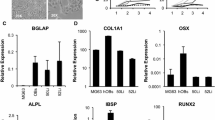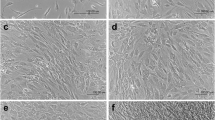Abstract
The proliferative capacity and cellular and biochemical characteristics of human trabecular bone osteoblasts were analysed throughout their replicative lifespan in vitro. Like several other cell types, human osteoblasts demonstrated a typical Hayflick phenomenon of cellular aging comprising a period of rapid proliferation until cumulative population doubling level (CPDL) 22 to 24, followed by a phase of slow growth and the final cessation of cell division at CPDL 32 to 34. Comparing young cells (less than 20% lifespan completed) and old cells (more than 90% lifespan completed) revealed a progressive increase in population doubling (PD) time, a decrease in attachment frequency, a decrease in the number of S-phase positive cells, a decrease in the rates of DNA, RNA and protein synthesis, an increase in the protein content per cell and an increased proportion of senescence-specificβ-galactosidase positive cells. While osteoblastic production of collagen type I decreased progressively during aging, alkaline phosphatase activity dropped rapidly after the first few passages and then remained constant during the rest of the proliferative lifespan. Significant morphological changes from thin and spindle-shaped early passage young cells to large, flattened and irregularly shaped late passage old cells full of intracellular debris were observed. In comparison, osteoblasts established from an osteoporotic bone sample showed a maximum CPDL of less than 5, had a longer PD time and exhibited abnormal senescent morphology. Thus, we have demonstrated for the first time that human osteoblasts, like several other diploid cell types, have a limited proliferative capacity in vitro and undergo aging and senescence as measured by various cellular and biochemical markers. In addition, preliminary studies show that cells from osteoporotic bone have a severely reduced proliferative capacity. This model of bone cell aging facilitates study of the molecular mechanisms of osteoblast senescence as well as factors related to osteoblast dysfunction in patients with osteoporosis.
Similar content being viewed by others
References
Parfitt AM. Bone remodelling: relationship to the amount and structure of bone, and the pathogenesis and prevention of fractures. In: Riggs BL, Melton LJ, editors. Osteoporosis: etiology, diagnosis and management. New York: Raven Press, 1988:45–93.
Kassem M, Melton LJ III, Riggs BL. The type I/type II model for involutional osteoporosis. In: Marcus R, Feldman D, Kelsey J, editors. Osteoporosis. New York: Academic Press, 1996:691–702.
Hayflick L, Moorhead PS. The serial cultivation of human diploid strains. Exp Cell Res 1961;25:585–621.
Hayflick L. The limited in vitro lifetime of human diploid cell strains. Exp Cell Res 1965;37:614–36.
Rattan SIS, editor. Cellular ageing. Mutat Res 1991;256:67–332.
Campisi J. Replicative senescence: an old lives’ tale? Cell 1996;84:497–500.
Chavassieux PM, Chenu C, Valentin-Opran A, Merle B, Delmas PD, Hartman DJ, et al. Influence of experimental conditions on osteoblast activity in human primary bone cell cultures. J Bone Miner Res 1990;5:337–43.
Koshihara Y, Hirano M, Kawamura M, Oda H, Higaki S. Mineralization ability of cultured human osteoblast-like periosteal cells does not decline with ageing. J Gerontol Biol Sci 1991;46:B201–6.
Koshihara Y, Honda Y. Age-related increase in collagen production in cultured human osteoblast-like cells. Mech Aging Dev 1994;74:89–101.
Fedarko NS, Vetter UK, Weinstein S, Robey PG. Age-related changes in hyaluronan, proteoglycan, collagen, and osteonectin synthesis by human bone cells. J Cell Physiol 1992;151:215–27.
Sutherland MSK, Rao LG, Muzaffar SA, Wylie JN, Wong MM, McBroom RJ, Murray TM. Age-dependent expression of osteoblastic phenotypic markers in normal human osteoblasts cultured long term in the presence of dexamethasone. Osteoporos Int 1995;5:335–43.
Ankersen L, Kassem M, Østergaard LH, Eriksen EF, Clark BFC, Rattan SIS. Ageing of human trabecular osteoblasts in culture. Arch Gerontol Geriartr 1994;(Suppl 4):5–12.
Kassem M, Blum W, Ristelli J, Mosekilde L, Eriksen EF. Growth hormone stimulates proliferation and differentiation of normal human osteoblast-like cells in vitro. Calcif Tisse Int 1993;52:222–6.
Derventzi A, Rattan SIS, Clark BFC. Phorbol ester-induced reorganization of the cytoskeleton in human fibroblasts during ageing in vitro-Biochem Biophys Res Commun 1992;182:1423–8.
Dimri GP, Lee X, Basile G, et al. A biomarker that identifies senescent human cells in culture and in aging skin in vivo. Proc Natl Acad Sci USA 1995;92:9363–7.
Bradford MM. A rapid and sensitive method for quantitation of microgram quantities of protein utilizing the principle of proteindye binding. Anal Biochem 1976;72:248–54.
Kassem M, Mosekilde L, Eriksen EF. 1,25-Dihydroxyvitamin D3 potentiates fluoride-stimulated collagen type I production in cultures of human bone marrow stromal osteoblast-like cells. J Bone Miner Res 1993;8:1453–8.
Kassem M, Rungby J, Mosekilde L, Eriksen EF. Ultrastructure of human osteoblasts and associated matrix in culture. APMIS 1992;100:491–8.
Hayflick L. Ageing under glass. Mutat Res 1991;256:69–80.
Rattan SIS. Ageing: a biological perspective. Mol Aspects Med 1995;16:439–508.
Holliday R. Understanding ageing. Cambridge: Cambridge University Press, 1995.
Takahashi Y, Yoshida T, Takashima S. The regulation of intracellular calcium ion and pH in young and old fibroblast cells (WI-38). J Gerontol 1992;47:B65–70.
Rattan SIS. Synthesis, modifications and turnover of proteins during ageing. Exp Gerontol 1996;31:33.47.
Rosenberger RF. Senescence and the accumulation of abnormal proteins. Mutat Res 1991;256:255–62.
Lips P, Courpron P, Meunier PJ. Mean wall thickness of trabecular bone packets in human iliac crest: changes with age. Calcif Tissue Res 1978;26:13–7.
Eriksen EF. Normal and pathological remodeling of human trabecular bone: three dimensional reconstruction of the remodeling sequence in normal and in metabolic bone disease. Endocr Rev 1986;7:379–498.
Liang CT, Barnes J, Seedor JG, Quartuccio HA, Bolander M, Jeffrey JJ, Rodan GA. Impaired bone activity in aged rats: alterations at the cellular and molecular levels. Bone 1992;13:435–41.
Gonchoroff DG, Branum EL, Edel SL, Riggs BL, O’Brien JF. Clinical evaluation of high-performance affinity chromatography for the separation of bone and liver alkaline phosphatase isoenzymes. Clin Chim Acta 1991;199:43–50.
Eastell R, Peel NF, Hannon RA, Blumsohn A, Price A, Colwell A, Russell RG. The effect of age on bone collagen turnover as assessed by pyridinium crosslinks and procollagen I C-terminal peptide. Osteoporos Int 1993;3(Suppl 1):100–1.
Schmidt R, Kulbe KD. Long-term cultivation of human osteoblasts. Bone Miner 1993;20:211–21.
Derventzi A, Rattan SIS. Homeostatic imbalance during cellular ageing: altered responsiveness. Mutat Res 1991;256:191–202.
Beresford JN, Gallagher JA, Russell RGG. 1,25-Dihydroxyvitamin D3 and human bone-derived cells in vitro: effects on alkaline phosphatase, type I collagen and proliferation. Endocrinology 1986;119:1776–85.
Owen TA, Aronow M, Shalhoub V, et al. Progressive development of the rat osteoblast phenotype in vitro: reciprocal relationships in expression of genes associated with osteoblast proliferation and differentiation during formation of the bone extracellular matrix. J Cell Physiol 1990;143:420–30.
Cohen-Solal ME, Shih MS, Lundy MV, Parfitt AM. A new method for measuring cancellous bone erosion depth: application to the cellular mechanism of bone loss in postmenopausal osteoporosis. J Bone Miner Res 1991;6:1331–8.
Darby AJ, Meunier PJ. Mean wall thickness and formation periods of trabecular bone packets in idiopathic osteoporosis. Calcif Tissue Int 1981;33:199–204.
Marie PJ, Sabbagh A, Vernejoul MC, Lomri A. Osteocalcin and deoxyribonucleic acid synthesis in vitro and histomorphometric indices of bone formation in menopausal osteoporosis. J Clin Endocrinol Metab 1989;69:272–9.
Author information
Authors and Affiliations
Rights and permissions
About this article
Cite this article
Kassem, M., Ankersen, L., Eriksen, E.F. et al. Demonstration of cellular aging and senescence in serially passaged long-term cultures of human trabecular osteoblasts. Osteoporosis Int 7, 514–524 (1997). https://doi.org/10.1007/BF02652556
Received:
Accepted:
Issue Date:
DOI: https://doi.org/10.1007/BF02652556




